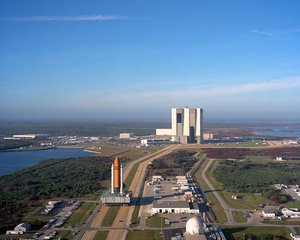STS-36
|
|
| Mission Insignia | |
|---|---|
 | |
| Mission Statistics | |
| Mission: | STS-36 |
| Shuttle: | Atlantis |
| Launch Pad: | 39-A |
| Launch: | February 28, 1990, 2:50:22 a.m. EST |
| Landing: | March 4, 1990, 10:08:44 a.m. PST |
| Duration: | 4 days, 10 hours, 18 minutes, 22 seconds |
| Orbit Altitude: | 132 nautical miles (245 km) |
| Orbit Inclination: | 62.0 degrees |
| Distance Traveled: | 1,920,000 mi 3090 Mm (approx.) |
| Crew photo | |
| Missing image STS036(S)002.jpg | |
STS-36 was a space shuttle mission by NASA using the Space Shuttle Atlantis. It was the 34th mission, and carried a payload for the U.S. Department of Defense (believed to have been a Misty reconnaissance satellite). It was the 6th flight for Atlantis.
| Contents |
Crew
- Commander: John O. Creighton (flew on STS-51-G, STS-36 & STS-48)
- Pilot: John H. Casper (flew on STS-36, STS-54, STS-62 & STS-77)
- Mission Specialist: Richard Mullane (flew on STS-41-D, STS-27 & STS-36)
- Mission Specialist: David C. Hilmers (flew on STS-51-J, STS-26, STS-36 & STS-42)
- Mission Specialist: Pierre J. Thuot (flew on STS-36, STS-49 & STS-62)
Mission Parameters
- Mass: 19,600? kg Payload Advanced KH-11 photo-reconnaissance satellite
- Perigee: 198 km
- Apogee: 204 km
- Inclination: 62°
- Period: 88.5 min
Mission Highlights
Department of Defense mission. Classified payload.
It has been reported that STS-36 deployed an Advanced KH-11 photo-reconnaissance satellite that used an all-digital imaging system to return pictures. The satellite was placed into a low earth orbit with a high-inclination to the equator to allow coverage of most of the Earth's surface. The KH-11 series is a digital imaging photo- reconnaissance satellite with both visual and infrared sensors.
February 28, 1990, 2:50:22 a.m. EST. Launch set for February 22 postponed to Feb 23, February 24, and February 25 due to illness of the crew commander and weather conditions. First time since Apollo 13 in 1970 that manned space mission was affected by illness of crew member. Launch set for February 25 scrubbed due to malfunction of range safety computer. Launch set for February 26 scrubbed due to weather conditions (Note: external tank loaded only for launch attempts on February 25 and 26, and launch on February 28). Launch February 28 set for classified window lying within launch period extending from 12 midnight to 4 a.m. EST. Launch Weight: Classified.
Atlantis landed at 10:08 a.m. PST on lakebed runway 23 ending the STS-36 Department of Defense mission. The total distance the orbiter rolled out was 7,900 feet (2.41 km). Atlantis was towed to the Mate Demate Device by about 3 p.m. PST.
About 62 dings in the tiles were counted by the debris team. Tile engineers reported that only one tile may have to be replaced. The brakes and tires performed nominally. Drops of hydraulic fluid were observed in the right main landing gear wheel well, the liquid hydrogen 17-inch (430 mm) disconnect cavity and possibly around two of the main engines.
Related articles
- Space science
- Space shuttle
- List of space shuttle missions
- List of human spaceflights chronologically
External links
- NASA mission summary (http://science.ksc.nasa.gov/shuttle/missions/sts-36/mission-sts-36.html)
| Previous Mission: STS-32 |
Space Shuttle program | Next Mission: STS-31 |

